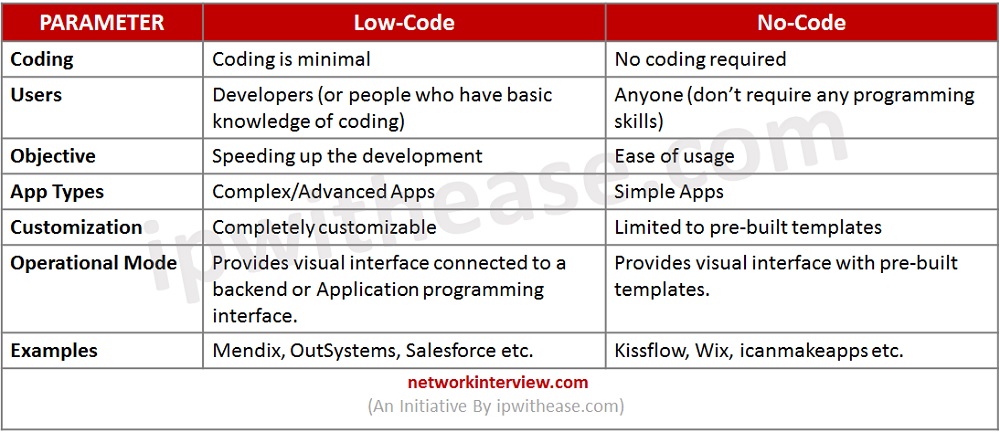
Low-Code vs No-Code Platforms: Detailed Comparison
Low-code vs No-code
No-code and low-code software are both ways of building apps with limited coding experience. But they each have their own advantages and disadvantages. Choosing the right one for your team and project can help you create an app faster and with less hassle.
No-code platforms allow users to build apps by dragging and dropping pre-built modules that have simple menus and prompts that guide users to build an app quickly. Low-code platforms take this a step further by allowing programmers to set up functions in pre-made blocks of code that can be dragged and dropped into place, which means less code is needed overall.
Let’s look at how low-code vs no-code software solutions compare:
Low-code Platforms
Low-code platforms are designed for users who know how to code and have programming knowledge. These platforms have pre-made blocks of code that can be dragged and dropped into place to create a desired app. Many low-code platforms also have pre-built modules that allow users to save time by reusing pre-existing code. Low-code platforms are great for people who already know how to code but need an easy way to manage and organize their code.
Pros of Low-code Platforms
- Customizable flexibility – Low-code platforms allow users to create custom apps that can be as simple or complex as needed. This means you can add custom code as needed, but you don’t have to start from scratch.
- Shorter app building times – If a user reuses code from a previous project, the app building process can be quicker. If a user creates a brand new app, low-code platforms may be even quicker than no-code platforms.
- Wide platform scalability – If a user creates a platform and saves the code, that code can be used on other devices and platforms. This means a user can simply copy and paste the code into a different platform to use it again.
Cons of Low-code Platforms
- Higher upfront costs – Low-code platforms can be more expensive than no-code platforms since they require programming knowledge.
- More time to learn – Users with low-code platforms need to spend time learning how to code and how to use the pre-made code blocks. This means more time is needed to build an app compared to no-code platforms.
- Limited to the platform – If a user has to build a brand new app and has no code to copy and paste, they’re limited to the options available on the low-code platform.
No-Code Platforms
No-code platforms are the simplest form of app building software. A user simply chooses from pre-built modules that represent parts of a desired app, such as a video feature or a contact form. The modules can be dragged and dropped in place to create the desired app. The app can be saved, edited, and added to a server for use by different users.
No-code platforms are great for people who want to build an app but don’t want to learn how to code. Alternatively, some no-code platforms can be used for people who know how to code but want to speed up their app building process.
Pros of No-code Platforms
- No upfront costs – No-code platforms are usually free to use. Costs may be incurred if there’s an option to export the app to a server and make it accessible to others.
- Easy beginner-friendly process – No-code platforms are designed with basic technology in mind, meaning they are designed to be easy to understand and navigate through.
- Shorter app building times – Since no-code platforms are designed to make app building quick, they can save you time and effort compared to low-code platforms.
Cons of No-code Platforms
- Limited flexibility – No-code apps have pre-built features that may not fit the needs of your app exactly. This means more time may be spent editing features to fit your needs.
- Fewer control options – With no-code platforms, you’re limited to the features and modules that come with the platform. This means you can’t include any custom code or make changes to the platform itself.
- Limited scalability – No-code platforms are built to be easy to use, which means their apps may not be as scalable as low-code platforms. Scalability in this context refers to how an app can be used on different platforms and devices.
Low-code vs No-code Platforms: The Difference
- No-code platforms are great for people who don’t know how to code. Low-code platforms are for people who know how to code but want an easier way to manage their code.
- Low-code platforms have pre-built code blocks and modules that can be dragged and dropped into place. No-code platforms allow users to create apps by dragging and dropping pre-built modules that have simple menus and prompts.
- No-code platforms are designed to be easy to understand and use. Low-code platforms let you include custom code, but they are still designed to be easy to understand and use.
- No-code platforms are best for apps that don’t need to be highly customized. Low-code platforms let you create apps that are highly customized and meet unique needs.
Comparison Table: Low-code vs No-code

Download the comparison table: low-code vs no-code
Bottom line
No-code platforms are great for people who want to create an app but don’t want to learn how to code. Low-code platforms are best for users who know how to code and want an easy way to manage and organize their code. With no-code platforms, you can build an app with no experience or knowledge of coding. Low-code platforms require at least some knowledge of coding and programming.
Continue Reading:
What is a No-code Platform? Will it replace Experienced Developers?
Low-Code Platform: The New Way to Build Software Applications
Tag:comparison, services, software



